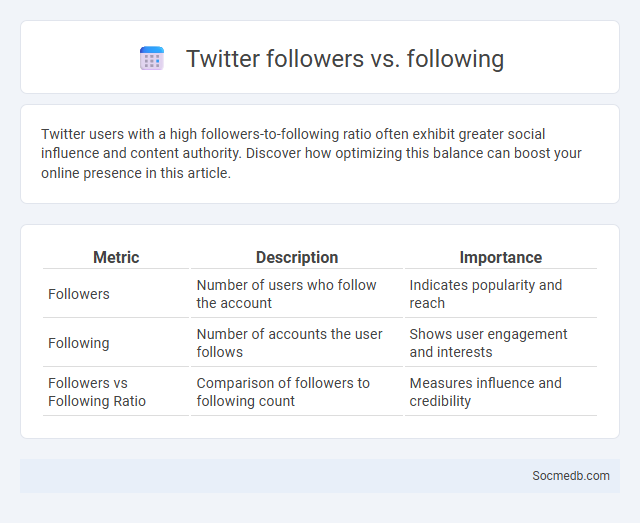
Photo illustration: Twitter followers vs following
Twitter users with a high followers-to-following ratio often exhibit greater social influence and content authority. Discover how optimizing this balance can boost your online presence in this article.
Table of Comparison
| Metric | Description | Importance |
|---|---|---|
| Followers | Number of users who follow the account | Indicates popularity and reach |
| Following | Number of accounts the user follows | Shows user engagement and interests |
| Followers vs Following Ratio | Comparison of followers to following count | Measures influence and credibility |
Understanding Twitter Followers: Definition and Importance
Twitter followers represent users who subscribe to receive updates from a specific account, reflecting its reach and influence on the platform. The number and engagement level of these followers serve as critical metrics for brand visibility, audience trust, and potential market impact. Analyzing follower demographics and behavior enables targeted content strategies that enhance communication effectiveness and growth opportunities.
What Does “Following” Mean on Twitter?
Following on Twitter means subscribing to another user's tweets, allowing their posts to appear in your timeline for real-time updates. This action creates a one-way connection where you receive content without needing mutual approval, enhancing personalized information flow. The number of followers and following often indicates social influence and engagement level on the platform.
Key Differences Between Followers and Following
Followers are individuals who subscribe to your content, allowing them to receive updates and engage with your posts, while following refers to the accounts you choose to subscribe to for their updates. Your followers determine your reach and influence on social media platforms, impacting engagement metrics like likes, comments, and shares. Understanding the distinction between followers and following helps optimize your social media strategy for growth and interaction.
Why Twitter Follower and Following Ratios Matter
Twitter follower and following ratios significantly impact your social media credibility and influence by signaling authenticity and engagement levels to other users and algorithms. A higher follower count compared to the number of accounts you follow often leads your profile to be perceived as an authoritative source, boosting visibility and trustworthiness. Understanding and optimizing this ratio helps Your account attract genuine followers, increase reach, and enhance overall social media effectiveness.
How to Analyze Your Twitter Follower-Following Ratio
Analyzing your Twitter follower-following ratio involves comparing the number of followers you have to the number of accounts you follow, providing insights into your social media influence and engagement level. A higher ratio often indicates greater authority or popularity, helping you assess the effectiveness of your content strategy and audience engagement. Monitor this ratio regularly to adjust your interactions and grow your network strategically for improved reach and visibility.
Strategies to Increase Your Twitter Followers
Engage consistently by posting relevant content tailored to your target audience, utilizing trending hashtags and participating in Twitter chats to boost visibility. Collaborate with influencers and industry leaders to expand reach and credibility, while scheduling tweets at optimal times to maximize engagement. Analyze follower analytics regularly to refine content strategy, ensuring increased interaction and sustained follower growth on Twitter.
Managing Your Twitter Following List Effectively
Managing your Twitter following list effectively involves regularly evaluating the relevance and engagement of the accounts you follow to maintain a focused and valuable feed. Utilize Twitter's list feature to categorize and organize followed accounts by interest or industry, enhancing content discoverability and interaction efficiency. Periodic pruning of inactive or irrelevant accounts helps optimize the quality of your Twitter experience and supports targeted networking strategies.
Common Myths About Twitter Followers and Following
Many users believe that having a large number of Twitter followers directly correlates with influence, but engagement rates and content quality hold greater significance. Another common myth is that following thousands of accounts increases visibility, whereas Twitter's algorithm favors meaningful interactions over sheer numbers. Users often overlook that authentic connections and consistent, relevant content outperform rapid follower growth in building a strong online presence.
Impact of Follower-Following Balance on Twitter Influence
Maintaining an optimal follower-following balance on Twitter significantly enhances your influence by projecting credibility and authenticity to your audience. Accounts with a higher follower-to-following ratio tend to attract more engagement, as users perceive them as authoritative and trustworthy sources. Your ability to manage this balance strategically impacts visibility, network growth, and overall social media impact.
Best Practices for Growing and Engaging Your Twitter Audience
Consistently posting high-quality, relevant content that resonates with your target audience boosts engagement and follower growth on Twitter. Leveraging hashtags strategically increases content visibility, while actively participating in conversations and responding promptly to mentions builds a loyal community. Utilizing Twitter analytics helps identify peak posting times and popular content types, optimizing your growth strategy effectively.
 socmedb.com
socmedb.com